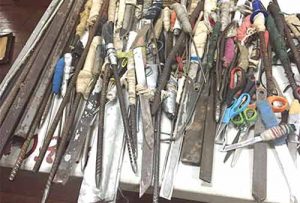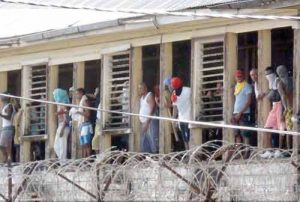Latest update March 31st, 2025 6:44 AM
Latest News
- ExxonM and CNOOC sticking to 11B barrels figure in Stabroek Block, but Hess says estimate higher
- Deadly Israeli strikes mar Gaza Eid celebrations
- Govt. to roll out automated speed ticketing system next week
- Bandits push down guard, rob Chinese nationals of over $1M in cash, other items
- Omai increases gold pit drilling
Cops seek possible charges for Camp Street blaze that killed 17
Jun 27, 2016 News
– prisoner IDs two inmates who put lit mattress behind door
By Michael Jordan
Police are to send a report today to its legal advisor, pertaining to the March 3 inferno that claimed the lives of 17 inmates of the Camp Street Prison.
The report contains details of an extensive investigation that the Guyana Police Force conducted into the tragedy.
It contains a statement from an inmate who identified two prisoners whom he claimed started the fire.
The inmate claimed that remand prisoners Shaka Mckenzie and Jermaine Otto, called ‘Fungus,’ started the blaze by lighting a mattress near a prison door.
Otto and Mc Kenzie were among the inmates that perished.
At the time of his death, Otto was on remand for the murder of dredge owner Ashook Ragghu, who was gunned down in August, 2014, during a robbery in Vlissengen Road. Mc Kenzie was reportedly incarcerated for armed robbery.
The inmate’s revelations were made during a lengthy investigation that the Guyana Police Force conducted into the tragedy.
Crime Chief Wendell Blanhum told Kaieteur News that the police report will be sent to legal officials as early as today, and that police are trying to ascertain whether anyone was culpable.
A Commission of Inquiry, ordered by President David Granger, was also held into the tragedy.
But also some of the prisoners who testified indicated that their fellow inmates started the fire, none of them named the culprits.
Blanhum said that police will also be sending the COI report to its legal advisors.
Seventeen inmates were trapped in the raging fire in the notorious Capital A Block of the Camp Street Prison.
The dead were : Kirk Clarke, Latchman Partap, Rohan Teekaram, Hillary Amos, Clifton Joseph, Chetram Dwarandat, Mohamed Asraf Ally, Richard Hubbard, Delroy Williams, Jermaine Otto, Randolph Marques, Rayon Paddy, Sherwin Trotman, Shaka McKenzie, Anthony Primo, Andrew Philander and Aaron Eastman.
The fire was reportedly started by inmates who were protesting against the conditions under which they were being housed, as well as the length of time they had to wait on remand before their cases could be heard.
During the Commission of Inquiry, some prisoners testified that some of their fellow inmates had set fires in the Capital Block on May 2. This led to prison officers searching cells and seizing several prohibited items, including cell phones (which some inmates were even using to post comments and photographs on social media) cutlasses, marijuana, and alcohol.
The prisoners alleged that the following day (March 3), several prisoners were removed from their cells and some were beaten.
This, some claimed, led to inmates setting the fires that caused the tragedy. Some said they survived by jumping through a hole that inmates had made in the wall between A and B Divisions of the Capital block.
Others who testified claimed that the deaths could have been averted if prison officials had opened the cell door to allow the trapped men to escape.
Instead, they claimed that a senior prison official had thrown tear gas and ordered his junior ranks to keep the cell door shut even as the fire escalated.
Prison officers who testified at the COI refuted many of the allegations made by testifying inmates.
Prison Task Force Officer Udistair Holligan
recalled hearing officers and inmates, alike shouting to the prisoners in an effort to help them escape the inferno.
He said that the men were told to escape through a hole but none of them complied. He also recounted the fear and intimidation which gripped the officers conducting the rescue operation.
When I am sitting in my quiet moments, thinking back to that date I can still hear the screaming, the threats…It was as if you know, you did your job to the best but you didn’t do it good enough to assist on that day,” Holligan stated.
And prison Officer Patrick Crawford was almost tearful as he talked of the inmates who perished in the fire. He noted that the men were once persons whom he had steady interactions with. “I feel sad to know that they are no longer here,” he said
Crawford told Commission Counsel, Excellence Dazzell, that on the day of the fire, he was part of the task force operation which was seeking to break up prison gangs, extract their ringleaders and sanitize Capital Cell Block ‘A’ of weapons and other contraband.
The witness said those moments before the violent fire consumed Capital ‘A’, firefighters and prison officer tried relentlessly to open the doors and free the prisoners, who were trapped inside. He said that it was as if the doors were jammed from inside.Crawford told the panel that his efforts to save men went beyond trying to open the door. He even went to the back of the building and instructed the men to climb through a hole in the wall that separated Capital ‘A’ and ‘B’ cell blocks of the jail house.However, the witness recalled that there was a “lit mattress,” partially blocking the hole.
The officer said, too, that when that attempt failed, he and other officers ran to the back of the building with sledgehammers and other tools to break the back wall of the prison and free the men. But this method was also unsuccessful as the fire had already consumed the area.
The prison officer recounted that by then there was thick black smoke emanating from the opening of the heavily secured building. At this time, Crawford said that he knew nothing could have been done to save the men.
Further questioned about his work at the prison, the official told the Commission that he had participated in mock fire drills at Camp Street Prison before but he could not recall whether checks were made to the doors to verify whether they were in proper working condition.
He stated that no tear gas was thrown into the burning building but only missiles (pieces of concrete blocks) which were tossed at joint forces officers by irate prisoners during the rescue operation.
The witness also noted that the officers of the prisons were not wearing any protective gear to combat the blaze.
Deputy Director of Prisons Gladwin Samuels was sent on leave during the Inquiry. However, Samuels was exonerated of all allegations at the end of the COI and has returned to duty.
At the conclusion of the COI, a report prepared by the Commission concluded that the excessive numbers of prisoners in the facility, delays in trials, and defective equipment contributed to the March 3 unrest.
The COI report noted that of the 60 percent of inmates of Camp Street prison on remand (604/1014), 149 are charged with murder, 50 percent have been awaiting trial for more than three years, and a further 30 percent for more than four years.
The report said that these figures and the lack of effective – or even ineffective action to remedy them, points to serious dysfunction in the administration of justice.
“For those not yet committed to trial in the High Court Preliminary Inquiries still have to be held. For those already committed, depositions have to be prepared before the cases can be called.”
“To this extent, this Commission of Inquiry cannot overlook the irony that Camp Street prison administration is now under investigation for performing a service thrust upon them over the years to off-set the limitations and negligence of the Judiciary/Magistracy.”
The report also recommended that the State consider the removal of the Georgetown Prison from the centre of the city.
The Commissioners highlighted the gross overcrowding and lack of adequate infrastructure within the prison facilities.
The report also noted that infrastructural deficiencies such as the non-completion of the new Brickdam Prison had placed unnecessary burden on the overcrowded Georgetown Prison. Recommendations were made for the complete construction of the new prison at Lusignan and upgrading Mazaruni Prison facilities to improve the prison holding capacity of prisoners under humane conditions.
According to the document “This prison has the capacity to house an additional 250 prisoners.”
The commission also noted the archaic state in which food in the prison is prepared.
Additionally, proposals were made for Capital A Block to be renovated and named ‘Centre of Learning and Reconciliation” for prisoners.
“It should have a good library with appropriate technology and other supporting material to aid inmates to develop themselves,” the document stated.
“Enhance the structure and equipment at the Cecil Kilkenny Prison Officers’ Training School at Lusignan to create a receptive learning environment for prison officers.”
The Commission also proposed a review of the internal walls of high security blocks to avoid prisoners breaking through them along with more effective system of lighting in dormitories to be introduced to avoid tampering and turning off of lights by prisoners in divisions.
Some prison officers have blamed their corrupt colleagues for putting their lives at risk by supplying prisoners with prohibited items.
The COI was chaired by retired Judge James Patterson and included former Prison Director Dale Erskine and Human Rights Activist Merle Mendonca.
Share this:
- Click to print (Opens in new window)
- Click to email a link to a friend (Opens in new window)
- Click to share on Facebook (Opens in new window)
- Click to share on WhatsApp (Opens in new window)
- Click to share on Twitter (Opens in new window)
- Click to share on Pinterest (Opens in new window)
- Click to share on Pocket (Opens in new window)
- Click to share on Tumblr (Opens in new window)
- Click to share on Reddit (Opens in new window)
- Click to share on LinkedIn (Opens in new window)
Related
Similar Articles

The Glenn Lall Show|| March, 28th, 2025
Follow on Tik Tok @Glennlall
THE BLUNT OF THE DAY

Sports
Mar 31, 2025
-as Santa Rosa finish atop of Group ‘B’ Kaieteur Sports- Five thrilling matches concluded the third-round stage of the 2025 Milo/Massy Boys’ Under-18 Football Tournament yesterday at the...Features/Columnists
Choosing between bad and worse
Peeping Tom… Kaieteur News- I’ve always had an aversion to elections, which I suppose is natural for someone who... more
The U.S. “Joining” the Commonwealth: an unreasonable expectation
By Sir Ronald Sanders Kaieteur News- Recent media stories have suggested that King Charles III could “invite” the United... more
Publisher’s Note
Freedom of speech is our core value at Kaieteur News. If the letter/e-mail you sent was not published, and you believe that its contents were not libellous, let us know, please contact us by phone or email.
Feel free to send us your comments and/or criticisms.
Contact: 624-6456; 225-8452; 225-8458; 225-8463; 225-8465; 225-8473 or 225-8491.
Or by Email: [email protected] / [email protected]
Weekend Cartoon


















